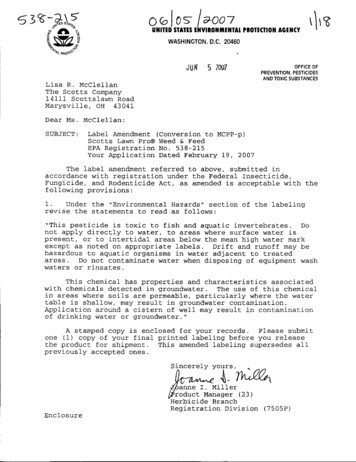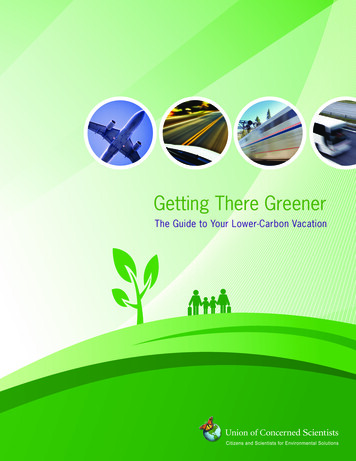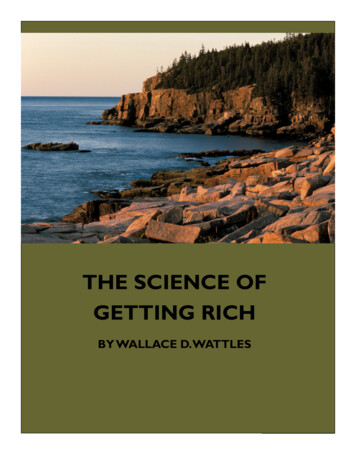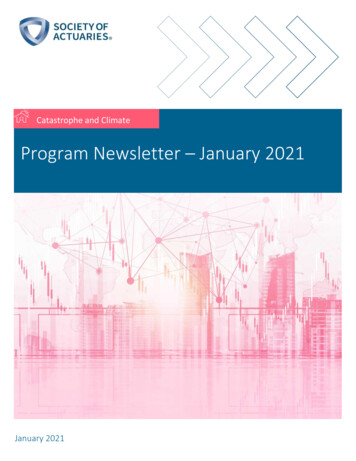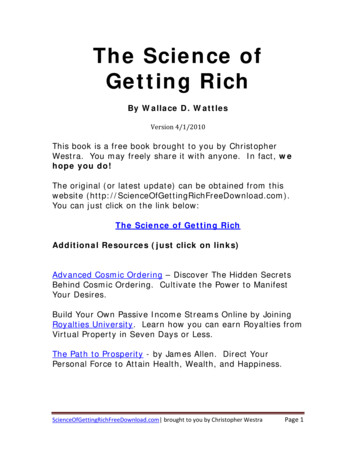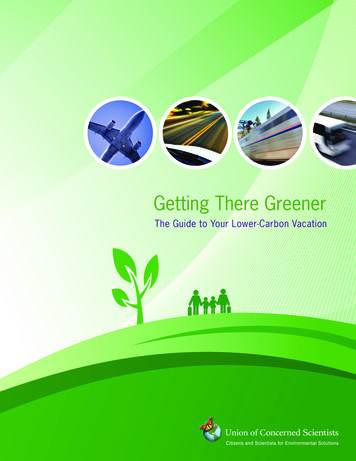
Transcription
Getting There GreenerThe Guide to Your Lower-Carbon Vacation
Getting There GreenerWhile the idea of “green” vacations has attracted recent attention, most information focuses onwhat to do when you get to your destination, not on how to get there. No definitive source hasbeen available to guide travelers toward the greenest travel option—trains, planes, automobiles, ormotor coach (a.k.a. buses)—for their particular vacation.The Union of Concerned Scientists (UCS) has turned its analytical eye toward the environmentalimpact of domestic vacation travel, where global warming pollution can add up quickly. The results ofour analysis may surprise you.One Vacation Can Be Worse ThanCommuting for a YearMeet “the Elsens,” our representative family of four from the suburbsof Chicago. They’ve been trying tominimize their impact on the environment, especially when it comes totheir commute. Dad drives a ChevyMalibu for his 10-mile round-triptravel to and from work. Momrecently switched from a Ford Explorer to a more efficient Ford Escape for her daily 25 miles of travel, whichincludes driving round-trip to work and carpooling thekids to and from after-school activities.This year, with the holidays coming up, the Elsensdecided to pull out all the stops for their first trip toDisney World and use frequent-flyer miles to travel firstclass. The chart below shows the resulting carbon footprint:Elsen Family Commute vs. First-Class Vacation10,000Pounds of CO Fortunately, a number of travel options are greenerthan those the Elsens selected. This new guide givesAmericans the tools they need to make sure they’regetting there greener.Your Guide to a Greener VacationHow are you traveling? Where are you going?Who’s tagging along?To create Getting There Greener, UCS performed the firstcomprehensive analysis—peer-reviewed by experts—ofthe highest-carbon and lowest-carbon options for vacation travel. (For more on how we approached our analysis,see page 7, or read our full-length report at www.ucsusa.org/gettingtheregreener.)In our analysis, three key factors determine the environmental impact of your travel: (1) the type of vehicleyou are taking; (2) the distance you are traveling; and(3) the number of people traveling with you. Based onthese factors, this guide can tell you how environmentallysound—or perhaps unsound—your travel plans are.1 ,0008,000 ,000 ,000 ,0000Annual FamilyWeekday CommuteFamily VacationNote: The comparison assumes that the Elsens’ Chevy Malibu gets 25 miles per gallon,their two-wheel-drive Ford Escape gets 23 mpg, and the family takes four first-classround-trip flights from Chicago to Orlando via Houston. Weekday commuting represents35 percent of the Elsens’ average annual automobile travel. Yes, you’re reading that right—the Elsens’ onevacation splurge produces more than one and a half timesthe global warming pollution created by their whole yearof commuting. These stats are a sobering reminder thatour carbon footprint is not merely a product of our dailyhabits, but of our vacation habits as well.Union of Concerned ScientistsOf course, Americans’ travel is not a matter ofabsolutes, as different regions have access to differenttransportation options. As you plan your journey, thetables to the right can help you evaluate each mode forsolo, couple, or family travel. What you find might surprise you, as your best travel bet can shift significantlydepending on the distance you travel and the size ofyour party.
Vacation Traveler Carbon GuideThe tables below list travel options from best to worst. Try to avoid those in red!Best Travel Options: Solo TravelerWorstBest100 miles500 miles1,000 milesTake motor coachTake motor coachTake motor coachTake trainTake trainFly economyFly economyFly economyTake trainDrive typical carDrive typical carFly first classDrive typical SUVFly first classDrive typical carFly first classDrive typical SUVDrive typical SUVBest Travel Options: Two TravelersWorstBest100 miles500 miles1,000 milesTake motor coachTake motor coachTake motor coachTake trainTake trainFly economyDrive typical carDrive typical carTake trainDrive typical SUVFly economyDrive typical carFly economyDrive typical SUVDrive typical SUVFly first classFly first classFly first classBest Travel Options: Family of FourWorstBest100 miles500 miles1,000 milesTake motor coachTake motor coachTake motor coachDrive typical carDrive typical carDrive typical carDrive typical SUVDrive typical SUVDrive typical SUVTake trainTake trainFly economyFly economyFly economyTake trainFly first classFly first classFly first classNotes: The red designation is a subjective assessment based on the distribution of total CO2 emissions across modes. The analysis assumes typical car andtypical SUV fuel economies of 23 mpg and 18 mpg, respectively. Train emissions reflect an average of electric and diesel operations. The analysis assumesturboprop use for 100-mile flights, regional jet use for 500-mile flights, and narrow-body jets for 1,000-mile flights, based on information from the FederalAviation Administration. We assume that all flights are nonstop. For more on the emissions factors we used, and the magnitude emitted by each mode, seethe full Getting There Greener report at www.ucsusa.org/gettingtheregreener.Getting There Greener
The tables on page 3 can give travelers an easy way tocompare travel options to fit their needs. However, ourGetting There Greener analysis also enabled us to create“rules of thumb” to help guide your initial travel choices,and to help you reduce your carbon footprint once youhave made those choices. Let’s start with the top traveltips, and then look more closely at each travel mode:Motor coaches and trains are a carbon bargain.Whether traveling with a family, with a partner, oralone, those seeking a carbon bargain should seriouslyconsider rail and motor coach travel. Intercity busoptions have been on the upswing, as numerousregional carriers now provide coaches with verycomfortable seats. And Amtrak offers everythingfrom high-speed rail service in the Northeast to“auto trains” that enable long-distance travelwithout the wear and tear on your car. From a carbonperspective, motor coaches and trains are amongyour lowest-emission options, especially on shorter(less than 500-mile) trips. Moreover, because motorcoaches and trains are often underused, they mayoffer what amounts to a carbon “free ride.”Big SUVs and first-class flights usually have thelargest carbon footprints. Driving alone, drivinginefficient SUVs (with or without other people), andflying first class are the most polluting ways to go. Tokeep your vacation’s carbon footprint down, considerother options.For couples and solo travelers, a nonstop coachflight almost always beats an average car. Carbonfrom cars and trucks adds up, especially when thosevehicles travel long distances and are only partiallyoccupied. If you’re traveling alone or with one otherperson, you’re usually better off flying direct in coachthan getting behind the wheel of a passenger vehicle.This is especially true for trips of more than 500 miles.To significantly reduce your carbon footprintbehind the wheel, drive or rent a more efficient car.If you don’t own a fuel-efficient vehicle, think aboutrenting one when driving on longer trips. The carbonemissions from a large, inefficient SUV are nearly Union of Concerned Scientistsfour times those of a high-mpg hybrid like the ToyotaPrius. If hybrids are not available, look into efficientconventional cars, which can ease the environmentalharm while cutting your gas bill. Many car rentalagencies now offer both hybrids and efficientconventional vehicles. Take advantage of them,and take some wear and tear off your car.Carbon Emissions Depend on the Auto You Drive:Couple Traveling 500 Miles1,200CO Emissions(Pounds per One-Way Trip)Top Five Rules of Thumb for Green alCarTypicalSUVWorstSUVNote: This analysis assumes a 46-miles-per-gallon hybrid car, a 32-mpg efficient car,a 23-mpg typical car, an 18-mpg typical SUV, and a 12-mpg worst SUV.Avoid traveling during peak periods. Congestionhas a noticeable effect on your fuel consumptionand carbon footprint. When a car or SUV is stuck intraffic, its fuel consumption rate can be double therate it gets at steady cruising speeds. So think aboutgetting a GPS unit for your car that can alert you totraffic hot spots in real time and suggest ways to avoidthem. (Some sell for as little as 150.) And think aboutchanging your vacation schedule to avoid peak travelperiods that keep you stuck in traffic.Now that you’ve decided whether to fly, drive, or takea train or motor coach, consider the following additionalrules of thumb from our analysis of each travel mode, toshave your emissions even further.
Vacation Carbon Tips: Air TravelDon’t stop. Choose nonstop flights overconnecting flights, especially for shorter trips.Because takeoff, landing, and ground operationsproduce a lot of carbon, a 1,000-mile nonstopflight from New York City to Orlando couldsave nearly 35 percent compared with a twoconnection flight down the eastern seaboard.If you must stop, fly straight. Travel websitesand agents can show you exactly how manymiles your flight will cover. If you can’t get anonstop flight, fly the most direct route possibleto save carbon.More seats less carbon. Make the marketwork. Choose airlines with all-economy seatingwhen possible, as they have smaller per-passenger carbon footprints.Carbon Emissions Depend on the Route You Take:Flying from Charlottesville, VA, to New York CityCO Emissions(Pounds per One-Way Trip)Class matters—save money and save carbon.When choosing seats, avoid first class. Becausea first-class seat takes twice the space of aneconomy seat, a first-class traveler on domesticflights is responsible for twice as much carbonas someone flying coach.*800 00 00 000Charlottesville- Charlottesville- CharlottesvilleNew YorkWashington, DCAtlantaNew YorkNew YorkCharlottesvilleCincinnatiBostonNew YorkNote: This analysis is based on actual routes and the type of aircraftused on each, whether turboprop, regional jet, or narrow-body jet.* Coach seats with more legroom—sometimes called “economy plus”—are responsible for an average of 20 percent more carbon than standard coach seats.Vacation Carbon Tips: Automobile TravelSolo and couples vacationing? Keep it inthe garage. Single travelers driving a typicalcar leave a large per-passenger footprint, whilecouples fare only a little better. Unless you’redriving a vehicle that gets more than 45 mpg,look for other options, such as the bus, train, oreven plane (economy seating, of course).Keep the family road-trip tradition alive.If you’re planning on bringing the grandparentsor the kids along for the ride, your per-personcarbon footprint shrinks accordingly. This makescars—especially efficient cars—a low-carbonoption for larger groups traveling together.Be car smart. How you pack, how you drive,and how you maintain your vehicle can savesignificant carbon and cash.Congestion guzzles excess gas. Select traveltimes carefully and consider routes that allowyou to avoid getting stuck inrush-hour traffic—especially if your trip takes youthrough congested areas.Getting There Greener
Vacation Carbon Tips: Rail TravelRide the rails in the Northeast to cut carbonand congestion. The Northeast Corridor isAmtrak’s most highly developed segment, soyou have more options, including high-speedAcela express trains between Washington, DC,and Boston. Because they run on electricity,Northeast trains are an even cleaner option.Even outside the Northeast, an Amtrakstation might be closer than you think.Check out your rail options even if you don’tlive near a train station. Amtrak’s ThruWay busservice connects most cities to rail stations.No rental required when training. Unlikemost airports, train stations are often right in citycenters, so you don’t have to hail a taxi or rent acar to get downtown, saving pollution as well astime. Amtrak also offers an “auto train” optionthat allows passengers to ride the train whilebringing their cars along for the ride.Take Me Out to the BallgameHere is one example of a chance to cut carbon emissions by taking the train. Vacationers traveling toMajor League Baseball stadiums will find that many are located near train stations:City Union of Concerned ScientistsMiles from airportMiles from train stationCoors Field (Denver)25.00.4Dodger Stadium (Los Angeles)20.01.8Minute Maid Park (Houston)18.61.1Busch Stadium (St. Louis)14.90.8Camden Yards (Baltimore)9.72.5
Vacation Carbon Tips: Motor Coach TravelMotor coaches leave carbon in the dust.A couple boarding a motor coach will cut theircarbon nearly in half compared with driving evena hybrid car. And if they take the motor coachrather than flying, they will cut their emissionsby 55 to 75 percent, depending on the distancethey travel.Group tours low carbon. Interstate tour-bustravel has seen a major expansion over the pastdecade. So think about that group trip in a new,green way.Not your daddy’s Greyhound. Today manycompanies have ditched their older buses andoffer plush new coaches with everything fromseat-back video to satellite radio to wirelessInternet connections.Search and ye shall find. You can jump-startyour low-carbon vacation with an Internetsearch. Bus travel—unlike air and rail travel—does not have a centralized reservations websitesuch as Orbitz, Expedia, Travelocity, or amtrak.com, but here are a few addresses to you getstarted: www.gotobus.com, www.greyhound.com, www.peterpanbus.com, www.trailways.com/schedules.asp. Happy trails!Where you decide to go and how youget there is entirely up to you. It’s yourvacation. But prepped with rules of thumb andinformation about the carbon footprint of yourtravel options, perhaps next time you will getthere greener!How We Created Getting There GreenerOur analysis is based on energy consumption, ridership (passenger-miles), and CO2 emissions for each mode of travel. We obtained thatinformation from a number of government and commercial sources for the most recent year available, usually 2004–2005.We then used standard metrics to convert energy consumption to CO2 emissions, then divided by ridership to arrive at average poundsof CO2 emitted per passenger-mile traveled in each mode.Finally, we added upstream CO2 emissions—those associated with extracting, refining, and transporting a given fuel—to yield total pounds ofCO2 emitted per passenger-mile traveled in each mode. We estimated per-trip emissions by multiplying the latter number by distance traveled.The full text of this report is available online at www.ucsusa.org/gettingtheregreener.Photo credits: Front cover: iStockphoto.com/Björn Kindler (plane); iStockphoto.com (car); iStockphoto.com/Rob Vomund (train); iStockphoto.com/Tor Lindqvist (bus). Page 2: iStockphoto.com/Renee Lee. Page 3: 2008 JupiterImages Corp. (family in pool); iStockphoto.com/David H. Lewis (snowboarders). Page 5: iStockphoto.com/Vladimir Surkov (mother withchild); iStockphoto.com/Alessandro Oliva (plane); Erin Rogers (family in minivan). Page 6: iStockphoto.com/Marcus Lindström (woman on train); iStockphoto.com/Pete Collins (ballpark).Page 7: iStockphoto.com/Tor Lindqvist (bus); iStockphoto.com/José Carlos Pires (beach); iStockphoto.com/Tim McCaig (hybrid car).Getting There Greener
Getting There GreenerThe Guide to Your Lower-Carbon VacationWhile the idea of “green” vacations hasattracted recent attention, most informationfocuses on what to do when you get to yourdestination, not on how to get there. No definitivesource has been available to guide travelers towardthe transportation option—train, plane, automobile,or motor coach (a.k.a. bus)—that will produce theleast global warming pollution during a particularvacation. Until now.In Getting There Greener, the Union of ConcernedScientists presents the first comprehensive analysis—peer-reviewed by experts—of the highest-carbon andlowest-carbon options for vacation travel.This analysis shows that three key factorsdetermine the environmental impact of your travel:(1) the type of vehicle you are taking; (2) the distanceyou are traveling; and (3) the number of peopletraveling with you. Based on these factors, this guidecan tell you how environmentally sound (or perhapsunsound) your travel plans are.Where you decide to go and how you get thereis entirely up to you. It’s your vacation. But with ourrules of thumb and the information we provide aboutthe carbon footprint of your travel options, you’ll havethe tools you need to get there greener!The Union of Concerned Scientists is the leading science-based nonprofit organization working for a healthy environment and a safer world.National HeadquartersWashington, DC, OfficeWest Coast OfficeTwo Brattle SquareCambridge, MA 02238-9105Phone: (617) 547-5552Fax: (617) 864-94051825 K St. NW, Suite 800Washington, DC 20006-1232Phone: (202) 223-6133Fax: (202) 223-61622397 Shattuck Ave., Suite 203Berkeley, CA 94704-1567Phone: (510) 843-1872Fax: (510) 843-3785 2008 Union of Concerned Scientists
you are taking; (2) the distance you are traveling; and (3) the number of people traveling with you. Based on these factors, this guide can tell you how environmentally sound—or perhaps unsound—your travel plans are. Of course, Americans' travel is not a matter of absolutes, as different regions have access to different
